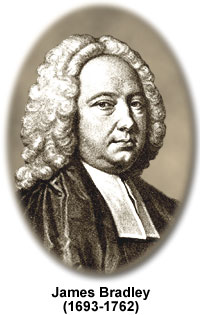James Bradley
(1693-1762)

James Bradley was an English astronomer most famous for his discovery of the aberration of starlight. The finding was an important piece of evidence supporting Copernicus's theory that the Earth moved around the sun, and also provided an alternative way to estimate the velocity of light.
Born in Sherborne, England, Bradley was the nephew of clergyman and amateur astronomer James Pound. His uncle trained him in astronomy from an early age and Bradley formally studied at Oxford University, from which he received a Bachelors degree in 1714, and a Masters in 1717. Fearing an inability to support himself financially as an astronomer, Bradley became a member of the clergy and was given a living at Bridstow. However, due to his scientific efforts and friendship with Edmund Halley, Bradley was elected a fellow of the Royal Society in 1718. An offer of professorship at Oxford followed in 1721, and twenty-eight year old Bradley quickly gave up his living at Bridstow in order to teach astronomy at the prestigious school.
A driving force in Bradley's career was his desire to measure the parallax of the stars, an apparent change in their positions that mirrored the change in the Earth's position in its orbit around the sun. Utilizing the observatory of his friend Samuel Molyneux, Bradley systematically studied the star Gamma Draconis and, though he did not successfully observe parallax, he made an important discovery while attempting to do so. Bradley found that Gamma Draconis did indeed shift in its location, but in the opposite direction from what was expected. He then deduced that the observed stellar variation in position was brought about by the aberration of light, a result of the finite speed of light and the forward movement of the Earth in its orbit.
Bradley announced his discovery to the Royal Society in 1728. The aberration of stellar light was of particular interest to the organization's members because it provided some proof for the extremely controversial heliocentric theory. The findings were also significant in that they provided another technique for calculating the speed of light. By analyzing measurements of stellar aberration angle and applying that data to the orbital speed of the Earth, Bradley was able to arrive at the remarkably accurate estimate of 183,000 miles (295,000 kilometers) per second.
Another important scientific contribution made by Bradley was the discovery of the nutation, or oscillation, of the Earth's axis. Bradley first noticed the fluctuation when he was carrying out his studies on parallax at Molyneux's observatory. However, since he believed that nutation was caused by the moon's gravitational pull, he decided to observe a full cycle of the motion of the moon's nodes, approximately 18.6 years, before announcing any findings. Completing his research in 1747, Bradley's discovery was finally made public in 1748 and was honored with the Copley Medal of the Royal Society that same year.
When Edmund Halley died in 1742, Bradley was named his successor as Astronomer Royal at Greenwich Observatory. He held the influential position for the rest of his life, greatly improving upon the condition of the observatory and the instruments it contained. Bradley also continued to study the stars and composed extremely accurate star charts, though the bulk of his observations would be published posthumously. He died on July 13, 1762, never realizing his hope of detecting the parallactic motion of the stars, but profoundly affecting the field of astronomy in his attempts to observe the elusive phenomenon.
